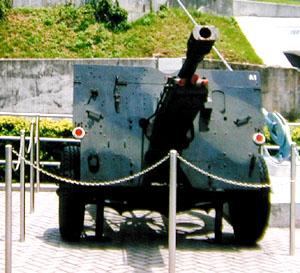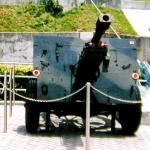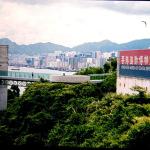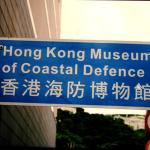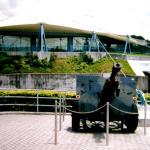Hong Kong's Museum of Coastal Defense
I find it a sad fact that so many Asian cities have become synonymous with military cataclysms. Think Saigon, for example, and you probably think of helicopters evacuating the American embassy as North Vietnamese tanks roll into town. Think Nanking and you likely remember the atrocities perpetrated by the Japanese military in 1937. Think Hiroshima and Nagasaki and without a doubt you see a pair of horrific mushroom clouds.
Consider Hong Kong, however, and you likely think of shopping and the Star Ferry. You probably don't think of warfare, and yet for centuries naval skirmishes and pirate attacks raged in the waters surrounding Hong Kong. During World War II the territory was the sight of a bloody battle that killed some 3,000 British and Japanese soldiers. As I recently discovered, this dark side of Hong Kong's history is well documented in the excellent Hong Kong Museum of Coastal Defense.
The Name Might be Dull but the Museum is Not
The Museum of Coastal Defense opened in 2000 and remains relatively unknown, perhaps because of its rather uninspiring name. If the museum really wants to pack people in, it might have to go for a new marketing strategy that can compete with the slick advertisements for Lancome, Toshiba and Dragonair that plaster everything in Hong Kong from shopping bags to subway walls. After all, though the museum has been heavily touted in the free brochures and maps offered at Hong Kong Tourist Association bureaus, this advertising campaign has been hobbled by the museum's dull name. Like a woman named Myrtle, the museum suffers from a moniker that most people find both bland and uncool. In a city where racy commercials and glitzy advertisements reign supreme, a name like the Cannons and Carnage Museum would surely attract more attention.
Prosaic name aside, the museum's obscure location also helps to limit the number of visitors to just 500,000 people per year. A half-million people a year is actually a relatively manageable level by crowded Hong Kong standards. Since most of the city is a mob scene, I found it a real pleasure to discover a venue that remained largely free of a crowd.
Museum Lies at End of the Line
Of course, to reach this uncrowded venue I had to literally ride to the end of the line. This journey took 30 minutes on one of the city's vintage street trams, which have been running continuously since 1904. A mobile museum piece, my tram swayed and rattled with the mechanical equivalent of the malarial shakes as it headed down King's Road. When the tram finally ran out of track in Shau Kei Wan, the driver stretched like a cat and kicked back to take a nap. I disembarked and found myself in an unremarkable neighborhood of apartment blocks typical of where most Hong Kong residents live.
The museum proved to be well signed, and like a lost child pursuing a trail of breadcrumbs, I followed these signs down the sidewalks of Shau Kei Wan. Though I plodded along at a slow pace, I quickly worked up a sweat in the steamy May heat. More signs led me under an elevated expressway and past a shipyard and wholesale fish market until finally I saw the ridge-top museum looming overhead like a castle on a hill.
I bought my ticket (HK$10 or US$1.40) in a reception area at the base of the ridge, then rode an elevator up to the museum itself. The elevator doors opened onto a skybridge that reached like a drawbridge to the museum, which had been integrated into the battlements of the former Lei Yue Mun Fort. I discovered that because the museum has been built into and over the ramparts, the fortifications comprise an integral part of the museum. The gun batteries, casements and ammunition bunkers have all been lovingly restored and put back into service as exhibition galleries chronicling some 600 years of coastal defense.
Ammunition Bunkers Turned History Displays
This interconnected set of galleries covers local naval history from the sailing junks of the Ming dynasty to the People's Liberation Army (PLA) patrol boats of the present day. All displays feature explanations in both Chinese and English. I think it's worth pointing out that in a city where English tends to be roughly handled, the English-language explanations at the museum proved to be smoothly written and grammatically flawless. This hardly surprised me, given the Smithsonian quality of the exhibits.
Despite the museum's name, the displays cover much more than just coastal defense. In fact, after spending a morning wandering the galleries I felt like I'd received a crash course in the military history of Hong Kong. I learned about 17th century sea battles between Qing-dynasty naval forces and pirates; I boned up on the Opium War and the British acquisition of Hong Kong in 1842. I got to know the hard-drinking and malaria-ridden colonial soldiers garrisoned at the fort in the years leading up to World War II. I studied an overview of the battle for Hong Kong in 1941 and the fate of the British soldiers who surrendered to the victorious Japanese.
I found an entire gallery devoted to the Royal Hong Kong Regiment, which is the closest thing to an indigenous military that modern-day Hong Kong has ever had. As an all-volunteer light infantry unit comprised of Hong Kong residents, the unit became popularly known as "The Volunteers," or simply "The Vols." During World War II the Vols fought bravely against the Japanese; post-war the Vols undertook a variety of duties ranging from riot control to border patrol. The colonial unit disbanded just prior to the Chinese handover in 1997 and the arrival of the PLA.
The PLA rates its own gallery, in fact, which in places veers into the stilted propaganda so often associated with the Chinese military. One part of the display proclaims the PLA to be "a mighty and civilizing force," for example. In general, however, the museum's exhibits offer an admirably balanced account of the various historical periods they cover.
Museum with a View
As if to compensate for the bloody nature of its displays, sunlight floods the central atrium of the circular museum. Overhead the tent-shaped roof soars like a great white flag of surrender, while on all sides of the atrium former ammunition magazines lead into underground display galleries. Industrial-strength air-conditioners chill the mid-summer air down to a temperature that would have astounded the colonial soldiers who once manned the fort's cannons in blistering East Asian heat.
I faced temperatures in the high nineties myself when I stepped outside the museum and onto the ramparts. From these sun-lashed battlements I had a commanding view of the narrow strait separating Hong Kong Island from the New Territories. A fleet of tankers, freighters and luxury liners coasted past like targets in a shooting gallery. Hitting an approaching warship with one of the fort's cannons would have been as easy as shooting the proverbial fish in a barrel. It didn't surprise me that the British garrison had thought their redoubt to be invulnerable, but it also didn't surprise me that when war finally came, the fort fell as quickly as a drunk with a belly full of rice wine.
Fort Falls Quicker than a Rice Wine Drunk
When the Japanese invaded the New Territories-the part of Hong Kong attached to the mainland-the outnumbered British garrison offered little resistance and retreated to Hong Kong Island instead. There they prepared for an Alamo-style last stand. Lei Yue Mun Fort comprised a key part of their defenses, as it guarded a likely crossing point for any Japanese assault. On December 18, 1941, Japanese landing craft disgorged troops on the shores of Hong Kong Island. The Japanese advanced quickly, and after a short battle, the defenders of Lei Yue Mun Fort retreated in disarray. All British forces surrendered eight days later on Christmas Day. Some 1,500 British, Canadian and Indian troops had died defending Hong Kong, and some 9,000 more would perish in brutal POW camps. In addition, at least 1,500 Japanese troops had died in action, while the privations of the war years would kill many Hong Kong Chinese civilians as well.
Hong Kong remained under Japanese occupation until 1945. Though the territory suffered some American bombing raids, the allies made no attempt to wrest Hong Kong back from the Japanese. This spared the city from further destruction and loss of life. Upon Japan's surrender, Allied forces reclaimed the territory from the Japanese garrison. As the British had no intention of returning Hong Kong to China at that time, the Royal Army posted a considerable number of troops in the colony. For years the army used Lei Yue Mun Fort as a training ground, though the redoubt itself became a military anachronism and fell into disrepair.
The Royal Army began scaling back its garrison in the years leading up to Hong Kong's return to China. As part of this rollback, the army transferred control of the overgrown and dilapidated Lei Yue Mun Fort to the city government. The government wisely chose to turn the fortress into a military museum rather than redevelop the land and plant yet more tower blocks on an island already groaning under the weight of uncounted skyscrapers.
The city government also chose to let the museum grounds function as an urban green space. The rocky, jungle-shrouded headland and its boulder-studded coastline comprise a typical Hong Kong landscape from the days before office blocks and freeways dominated the island. A paved walking trail snakes through the grounds past a trio of armored vehicles, several artillery batteries, some war-blasted buildings, a series of machine-gun emplacements, and an eerie brick-lined cave that once housed Brennan wire-guided torpedoes.
The New Armies of Hong Kong
A small army of security guards keeps an eye on these outdoor displays. In fact, there may be more security guards patrolling the museum than there were soldiers back in the days when it served as a military installation. The guards can be found everywhere-in old pillboxes, in exhibition galleries, atop the ramparts. I even found them down in the steamy purgatory of the moat, where the fortress walls still bear shrapnel scars from World War II.
The security guards do not carry firearms, for like the fort itself, they have been disarmed. Indeed, the same could be said of Hong Kong, a city once bristling with concrete fortifications but now largely demilitarized. The Royal Army has long since departed for Britain and the small PLA garrison keeps a low profile.
I returned from the museum on another clattering electric tram. Like an urban white-water rafter, I jostled and bumped down a river of traffic that carried me through canyons of apartment blocks, hotels and shopping malls. A battle still raged, but not between armies equipped with machine-guns and artillery pieces. Instead rival brand names duked it out-Starbucks against Deli France, Sony against Sanyo, Carlsberg against San Miguel-in an otherwise peaceful city. I sat back in my bench, watched Hong Kong flow past, and gave thanks that the weapons displayed in the Museum of Coastal Defense would fire no more.
* * * * *
Fact File
The Museum of Coastal Defense is at 175 Tung Hei Road. The museum is easily accessible from the MTR metro system, the tentacles of which stretch throughout the entire city. Catch the Island Line to Shau Kei Wan station, then take exit B2 out of the station and follow the signs to the museum. The walk from the station to the museum takes about 15 minutes; in the summer months this can be a very steamy walk, so you might consider paying for a short taxi ride to the museum.
Other options for getting to the museum from various points in Hong Kong include buses 84, 85 and A12. Buses are no cheaper than the MTR and almost always slower. Alternatively, you can go by electric street tram. The trams offer a scenic ride and are certainly cheap at HK$2 (US$0.25), but they are also slow, crowded and hot. Finally, you can opt for a taxi, which is the most comfortable option but also by far the most expensive.
The museum is open daily from 10 a.m. to 5 p.m. It is closed on Thursdays and the first two days of the Lunar New Year. Admission is HK$10 ($1.40), except on Wednesdays, when it is free. The museum has a snack bar and gift shop. Phone: 2569-1500. Website: www.lcsd.gov.hk/hkmcd. Email: hkmcd@lcsd.gov.hk.
If you want to learn more about the World War II battle for Hong Kong, I recommend Ruins of War: A Guide to Hong Kong's Battlefields and Wartime Sites by Ko Tim Keung and Jason Wordie. The Bookazine chain generally stocks this title, which sells for HK$120 (US$16).
* * * * *
 ThingsAsian
ThingsAsian